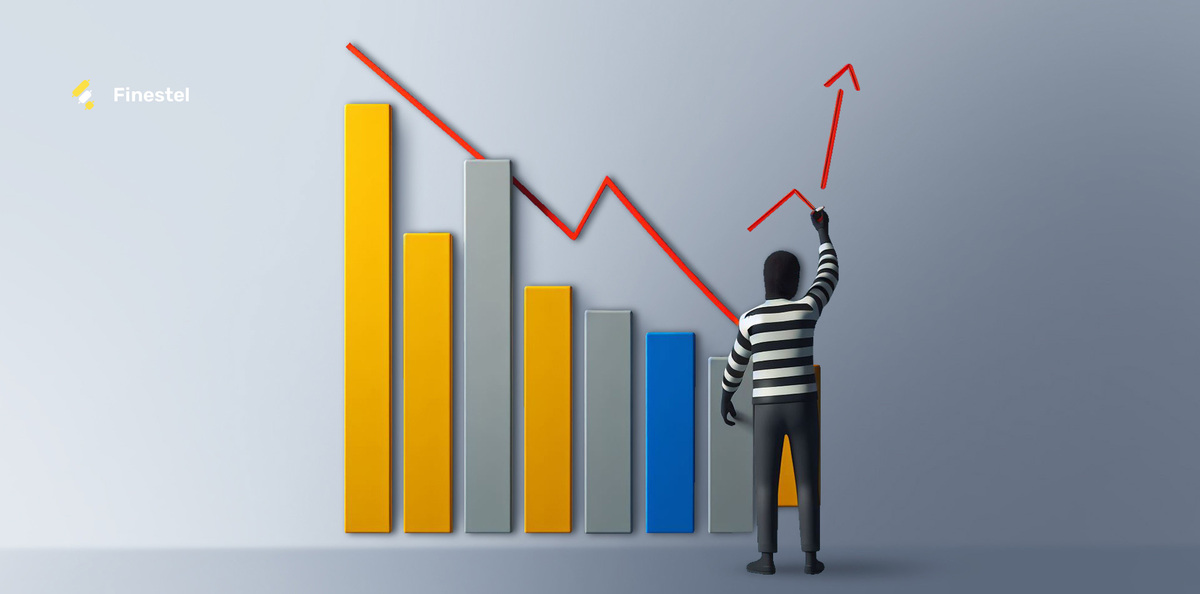A wave of phantom trades is haunting financial markets – but what is driving this specter, and what dangers does it pose? What is wash trading? Wash trading, the practice of buying and selling assets to create false impressions of market activity presents an enduring challenge for regulators and market integrity. This complex phenomenon involves varied techniques to manipulate different assets across global markets. Understanding wash trading requires examining its methods, motives, hazards, and the cat-and-mouse game between violators and enforcement.
Recent cases have uncovered multi-million dollar wash trading schemes involving futures, cryptocurrencies, and more. This highlights the practice’s ongoing appeal for deceiving investors and tax authorities or profiting from artificially-inflated prices. However, hefty fines and even jail time await those caught red-handed by increasingly watchful regulators.
This article by Finestel delves into wash trading’s shapeshifting forms, its impacts, and the deepening tools and coordination aiming to exorcise its invisible specter. Illuminating this phantom menace is key to properly accounting for its market-distorting risks.
What is Wash Trading?
Wash trading can be defined as a form of market manipulation that involves buying and selling the same or similar assets by the same or related parties to create artificial trading activity and volume. In other words, wash trading is a type of self-dealing that does not result in any change in the ownership or value of the assets, but only in the appearance of trading activity and volume. It can be done by individuals, firms, or groups, either directly or indirectly, using various methods and techniques.

Wash trading differs from other types of market manipulation, such as spoofing, layering, or pumping and dumping, in that it does not involve placing or canceling orders that are not intended to be executed, or creating false or misleading information or signals to influence the market. However, It can be used in combination with other types of market manipulation to achieve certain objectives or effects.
How is Wash Trading Implemented?
Wash trading employs varied techniques to manipulate markets, assets, and prices based on environments and objectives. Common methods create false impressions of activity and volume to deceive traders and oversight:
- Traders connect multiple personal and corporate accounts across centralized, decentralized, and OTC services to trade the same assets simultaneously, blurring genuine buying and selling flows
- Groups develop and deploy smart automated software, scripts, infrastructure, and plugin bots to efficiently generate high volumes of fraudulent wash trades that avoid human detection
- Wash traders participate in tokenized incentive programs rewarding recorded trading volumes to earn tokens, further motivating false volumes
- Traders create complex order layers using derivatives and leverage to disguise wash trading and multiply impacts
These approaches enable wash trading across assets like equities, commodities, currencies, and crucially, cryptocurrencies which present prime targets given structural vulnerabilities around transparency and global enforcement.
How Crypto Wash Trading Uniquely Leverages Emerging Technology for Market Manipulation
Cryptocurrencies unfortunately see highly sophisticated implementations manipulating perceptions and fundamentals:
- Developers collude by developing elaborate smart contract algorithms and protocol bots camouflaged within technical complexity to autonomously wash trade crypto assets without oversight
- Anonymous groups form across borders exploiting crypto’s pseudonymous features to discreetly message and collude on orchestrated wash trading schemes
- Wash traders route transactions through crypto mixers and tumblers after wash trades to further cloud public tracing and impede blockchain analysis investigations
- NFT wash trading uses separate wallets to trade perceived valuable NFTs back at inflated prices to boost “floor prices” and dupe retail traders.

Such crypto-specific tactics severely obscure situational understanding around asset values and pose acute risks to trader protection and fairness. Ongoing innovation responding to crypto wash trading techniques remains vital to prevent further market erosion.
This demonstrates crypto wash trading wielding emergent tools for deception and manipulation compared to traditional finance. But crypto similarly requires adapting governance, standards, and enforcement to match this expanding threat.
Market Making vs. Wash Trading
Market makers legitimately facilitate trading by providing liquidity with buy and sell orders, capturing small spreads that benefit market stability and availability. In contrast, wash trading manipulates activity solely for profit through deception without true transfers between separate parties. While regulation accommodates and encourages helpful activities with oversight, wash trading’s parasitic risks mandate elimination.
Spoofing vs. Wash Trading
Whereas spoofing rigs illusory signals to psychologically mislead traders, wash trading executes actual fraudulent transactions to accumulate assets using deception. Anti-manipulation policies distinguish intent and damage timelines – spoofing misleads decisions before resulting losses while wash trading’s asset transfers enable direct loss realization from inflated valuations. Both severely undermine integrity and fairness with likely behavioral overlaps. But technical distinctions help target deterrent policies as markets evolve.
Is Wash Trading Legal?
Wash trading is a controversial and contentious phenomenon that raises legal and regulatory issues and challenges, as it can violate or circumvent the laws and rules that govern the market and the asset, as well as the rights and obligations of the market participants and regulators. It can be illegal or legal, depending on the jurisdiction, market, and asset involved, as well as the intent and effect of the wash trading. Several key laws and regulations prohibit or restrict wash trading across financial markets:
Securities laws regulate the trading of stocks, bonds, and derivatives to protect investors and ensure fair, efficient markets. They often ban it as can manipulate prices, and volume or mislead participants. Examples include the 1934 Securities Exchange Act in the US and the Financial Services and Markets Act 2000 in the UK.
Tax laws govern income, capital gains, and other taxes to collect government revenue equitably and efficiently. They frequently restrict wash trading since it can illegally avoid or abuse tax obligations. For instance, the US Internal Revenue Code and the UK Income Tax Act 2007 prohibit abusive wash trading.
Commodity laws oversee the trading of commodities like metals and crops to protect producers, and consumers and promote stable markets. They typically prohibit wash trading that disturbs pricing or supply-demand fundamentals through manipulation. The US Commodity Exchange Act and others restrict such practices.
Common Wash Trading Ploys and Their Tricky Trade-Offs
Wash traders use different tricks aiming to profit or avoid costs – but these tactics also risk detection and cause collateral damage. Key wash trading types observed include:
- Dodging Taxes
- Traders may sell holdings at fake losses to erase tax bills from winners. This shelters income, but illegally avoids tax obligations reducing public resources.
- Profiting from Pumps
- Wash trading often deliberately inflates prices to spur buying hype and momentum. Traders then sell into temporary euphoria for fast profits leaving others with losses.
- Smoothing Illiquid Assets
- Wash trading can increase volumes to suggest ample buying and selling for troubled assets. But this glosses over real risks and worsens eventual corrections through false comfort.
While it offers short-term opportunities to beneficiaries, it simultaneously concentrates risks and erodes integrity. These practices ultimately enable exploitation outweighing benefits with politics, policies, technologies, and behaviors needing to shift in response. Though incentives exist on paper, collective actions must deter resulting real-world damages while better rewarding transparent markets where trusts and valuations become less spectral, distorted phenomena.
Investor impacts
Wash trading directly harms or misleads retail and institutional investors, as it affects their decision making and performance in the market. Some of the ways that wash trading harms or mislead investors are:
Wash trading creates false or misleading signals of market demand or supply, price movement or trend, and trading activity or volume, which can influence the investors’ perception and expectation of the market and the asset, and induce them to buy or sell the asset at unfavorable prices or times.
Wash trading inflates or deflates the market valuation and liquidity of the asset, which can affect the investors’ profitability and riskiness of the asset, and expose them to higher fees and commissions, taxes and duties, and volatility and uncertainty.

Wash trading reduces or eliminates the market efficiency, fairness, and transparency, which can impair the investors’ confidence and trust in the market and the asset, and discourage them from participating or investing in the market and the asset.
Therefore, wash trading can result in significant losses or opportunity costs for the investors, as well as damage their reputation and credibility in the market.
Read more about the MTFE Ponzi scheme.
Specific Examples of Investor Harm
Wash trading not only undermines market integrity but also directly impacts individual traders. Specific cases highlight the financial losses suffered:
- In Hong Kong, Merrill Lynch S.A. failed to halt a HK$100 million currency wash trading scheme, resulting in $13 million in investor losses and avoidable taxes.
- A Bulgaria-based crypto wash trade scam worth €55 million deceived investors with fake volumes, leading to losses ranging from €5,000 to €500,000 as coins were deemed worthless.
These instances illustrate how wash trading deceives and harms specific traders, concentrating gains for perpetrators while inflicting costs on the broader ecosystem. Tracking such costs is crucial for driving reforms and implementing technology to combat this harmful behavior effectively.
Read more in Coscoin review, the latest cryptocurrency hype that some are calling a scam.
Piercing Complexities to Uncover Wash Trading
Detecting wash trading poses challenges, as schemes exploit loopholes across assets and geographies. But emerging techniques shine a light:
- Analyzing Trade Data for Anomalies – Granular trade data can reveal volumes or sequences unlikely to occur naturally, indicating potential wash trading for further investigation.
- Monitoring Market Signals and Indicators – Tools assess market signals like shifting bid-ask spreads, volatility, or turnover spacetimes. Extreme swings absent news may suggest manipulation.
- Employing Statistical Analysis and AI Pattern Recognition – Revealing wash trading sometimes requires complex tools highlighting improbable correlations and causal chains identifying manipulation.
- Implementing Reporting Standards and Market Oversight – Wash trading decays transparency critical for fairness and accurate pricing. Upgraded reporting requirements, disclosures, supervision powered by technology can aid detection.
- Incentivizing Participant Awareness and Accountability – Informing stakeholders and incentivizing accurate monitoring strengthens community standards around ethics and protections.
Sophisticated markets require layered defenses. Combining data, analytics, governance, and culture crafts an environment that deters threats to integrity – helping remove shadows obscuring true asset values earned by innovation, service, and human progress.
The Cat and Mouse Game of Catching Wash Traders
Wash trading rule violations result in fines, disgorgements, suspensions, injunctions, and potential imprisonment based on severity, intent, and authority. Detection and enforcement face significant challenges due to evolving tactics. Notable cases include the U.S. CFTC fining Tower Research Capital $67.4 million in 2019 for treasury futures wash trading, Hong Kong’s SFC ordering HSBC Broking to pay $4 million in 2018 for enabling stock wash trades, and the UK FCA imposing a £34.5 million judgment against Merrill Lynch for securities wash trading neglect.
Regulators globally grapple with manipulative innovation, with the U.S. SEC struggling to enforce cryptocurrency wash trading, Hong Kong Stock Exchange criticized for enabling wash tricks due to poor transparency, and the UK audit regulator facing questions over wash trading enforcement competence and independence. Laws vary across regions based on historical context, cultural norms, and technical definitions, with the U.S. emphasizing case precedent and active policing, Hong Kong blending common and civic law for penalties and oversight, and the UK adopting a common law system with passive enforcement.
Regulators need to enhance reporting, surveillance, penalties, and industry cooperation to combat wash trading effectively and preserve market integrity by promoting accountability, transparency, and ethical practices.
Regulator Challenges and Technological Opportunities

- Standardized reporting APIs with detailed metadata enhance oversight capabilities.
- Stream analytics of consolidated data feeds enable real-time pattern detection.
- Cloud infrastructure provides cost-effective storage and computing power for in-depth analysis.
- Machine learning models utilizing financial deep learning can automatically identify anomalies for further investigation.
By combining technological advancements with strengthened policies, expanded analytical tools, and a culture promoting ethics and accountability, regulators aim to enhance their monitoring capabilities and combat wash trading effectively.
Exchange Standards and Incentives Against Wash Trading
Behavioral economics insights inform strategies to combat wash trading by shaping exchange policies and industry incentives:
- Implementing small transaction taxes can signal trading intent, adding minimal costs for most traders while deterring wash trading by increasing overall costs.
- Enforcing Know Your Customer identity requirements can enhance transparency by tracking account relationships, supported by analytics that identify abnormal grouped activities.
- Offering rewards to whistleblowers reporting wash trading can fund education initiatives, raise awareness, and provide incentives by offering a percentage of fines above regular salaries.
- Publicly disclosing individual firm wash trading violation rates linked to executive compensation can drive cultural change through accountability and competition.
By adopting these measures, exchanges can create environments hostile to wash trading, supplementing regulatory efforts with proactive industry standards and incentives.
Financial Institution Monitoring for Market Manipulation
Large financial groups like investment banks and brokerages sit at the intersection of capital, clients, and markets – uniquely positioning them to assist in catching wash trading schemes through responsible self-monitoring:
- Transaction Monitoring Systems: Banks run extensive platforms screening accounts and payments for money laundering – adapting these for wash trading could flag unusual exchange deposit patterns like circular asset movements.
- Client Profiling Analytics: Understanding client behaviors and risk factors helps construct profiles assessing propensities towards manipulation based on attributes, psychology, and incentive contexts.
- Exchange partnership data sharing: Securely providing regulators trade metadata for aggregation powers oversight leveraging bank scope while gathering intelligence aiding business risk management.
In collaborating with authorities and exchanges by wielding institutional data access and analytics, banks uphold market integrity principles while improving brand value – turning private policing into a competitive advantage supporting prevention over penalties.
Conclusion
Wash trading persists in financial markets despite enforcement efforts and technology. It’s a human-created issue driven by incentives for short-term gain over long-term stability. Solutions require transparency, accountability, and cooperation to promote fairness. Regulators need better governance and analytics, industry collaboration is key, and investors must stay informed and vigilant. By working together, we can expose deceptive practices and restore confidence in the market.





Leave a Reply